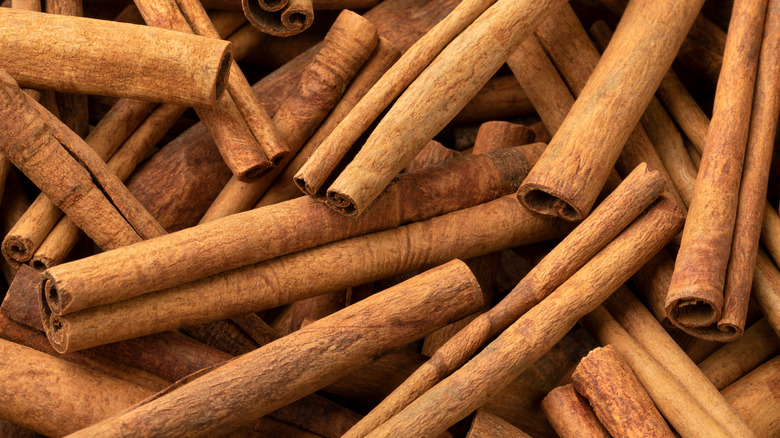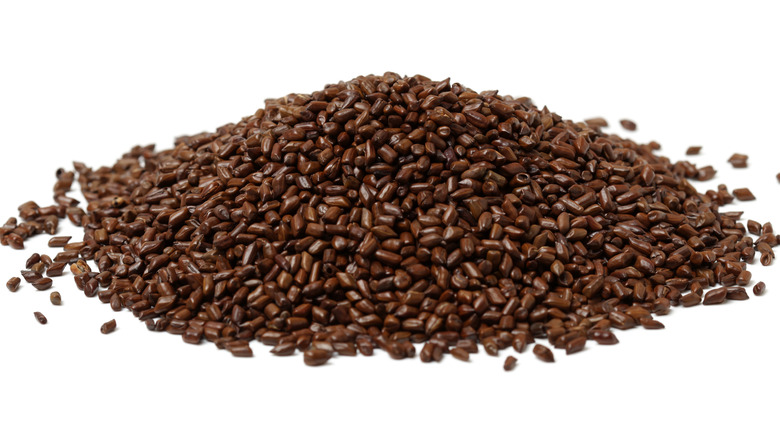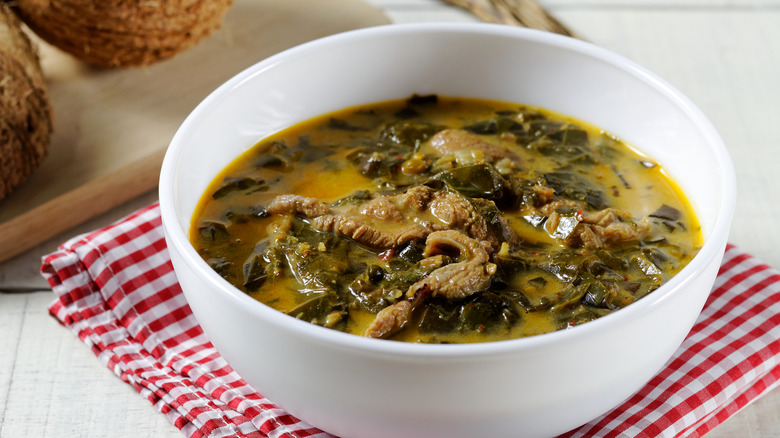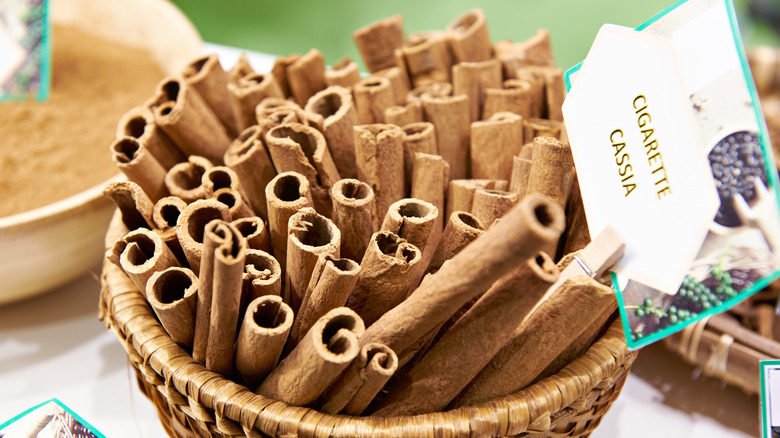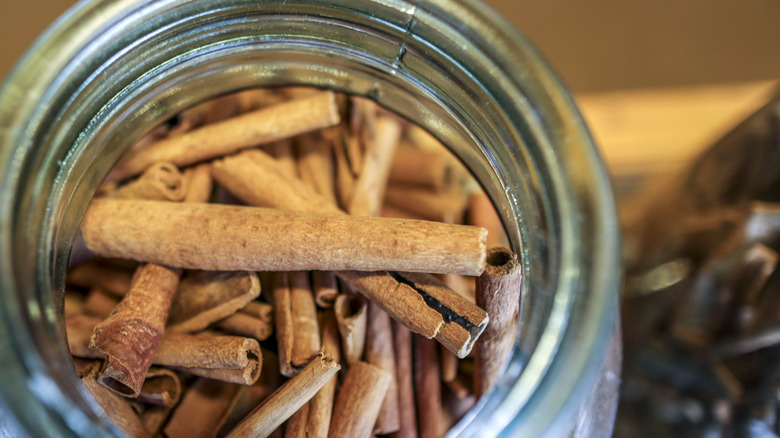What Is Cassia And What Does It Taste Like?
If you like to sprinkle a little cinnamon on your morning latte or enjoy snacking on a big round cinnamon roll topped with white icing for breakfast, chances are what you think is cinnamon is actually cassia. What's cassia? Well, at first glance, you might think cassia, also known by its scientific name as Cinnamomum Cassia, is just cinnamon. The two spices do look quite similar, so it is a logical assumption to make. However, per Glen and Friends Cooking, while they are both from the laurel plant family, the two have "slightly different flavors" and hail from two different places (via YouTube).
Cassia, which the University of Iowa shares comes from the inner bark of the evergreen tree, is often called "Chinese cinnamon." It is native to Central China while true cinnamon can be found almost exclusively in Sri Lanka. But Glen and Friends Cooking notes that what might surprise most people is the fact that when you go to buy cinnamon at the grocery store, be it ground or in stick form, you are actually getting cassia. How can you tell the difference between cinnamon and cassia? The trick to telling them apart is all about the curling. True cinnamon sticks are going to have what they describe as a spiral form, meaning it curls into concentric, tubular sections. Cassia, on the other hand, curls inward on both sides and looks more like a scroll.
How is cassia made?
According to National Geographic, cassia's production is a hands-on experience for growers and begins with the harvesting of the tree bark. Evergreen trees are planted and allowed to grow for at least 10 years before they are cut down and the outer bark is removed to reveal the inner bark that will be dried. It is during the drying process the cassia curls and takes on the scroll form we all know and love.
What is fascinating is new trees can grow from the stumps of harvested trees which makes this a sustainable practice for farmers in Indonesia. Per Britannica, once the bark is dried, the color has a range. The thicker the bark, the grayer it will be in color. Thinner bark is going to have the reddish-brown hue we are so accustomed to seeing on the store shelves. But when it is ground, cassia is reddish-brown.
What does cassia taste like?
Cassia has been around forever — for thousands of years, actually. According to Richard Farrester on Medium, this spicy tree bark can claim Biblical origins. Why? Because the Bible makes mention of the spice in both the "Book of Exodus" as an oil and fragrance and the "Book of Ezekiel" as a commodity that was used in trade.
As for how it tastes, the University of Iowa explains that cassia's flavor is a "bit simpler" but also more intense than true cinnamon. If you are wondering why, the answer stems from the fact that there is a high amount of oil in its bark. Cassia is often described as "warm" and "sweet" to the tongue with a hint of spiciness to shake things up for your taste buds. The scholarly site also reveals that cassia contains a blood-thinning agent known as coumarin which is not necessarily harmful unless you are taking blood-thinning medications. For this reason, moderation is suggested; WebMD cautions that consuming more than 6 grams of cassia daily can cause liver problems.
How to cook with cassia
So, in what recipes should you be using cassia? The Spruce Eats suggests that the spice works best in dishes that have more salty elements than sweet, going on to share that it is not only the bark of cassia that can be used in cooking. Foods of Nations explains that dried cassia buds, which look a lot like cloves and are the cassia flowers that do not bloom, also impart a cinnamon-like flavor to the foods they touch and are excellent to use when pickling, brewing up a good cup of tea, or adding a little kick to meat marinades.
Dried cassia leaves can also be a game-changer for your spice arsenal. Cassia leaves can add a new depth to your soups, chilis, and stews in a similar manner to how you use bay leaves. In fact, the cinnamon imposter has become ubiquitous in cuisines all over the world. The University of Iowa shares that it is used in five-spice powder in China, as well as in moles in Mexico. In Guatemala, it is a staple in coffee. To put it succinctly, cassia's cinnamon taste can be found pretty much everywhere.
Where to buy cassia
Cassia is pretty ubiquitous. You can find this variety of cinnamon at any grocery store. However, if you are looking for a top brand, Epicurious did a taste test and found Frontier Co-op to be a standout in a rather crowded space of this spice. It comes from Indonesia and is derived from Korintje cinnamon, which is closely related to cassia. Because its taste was "warm and sweet, but with a welcome kick of heat" it is perfect for both savory and sweet recipes. The food site also notes this is the type of cinnamon that makes Cinnabon's cinnamon rolls smell so irresistible. Frontier Co-op cinnamon can be purchased online.
When storing your cassia, you want to make certain you keep it in an airtight container. Ground cinnamon goes stale quickly and can lose its scent and punchy power, so best not to buy in large quantities. Mrs. Fields suggests ground cassia or cinnamon can keep their freshness for a year, maybe two, while sticks of the same spice can last much longer.
Nutritional information about cassia
Lastly, if you are a fan of all things warming spices, you will be happy to learn that cassia cinnamon also has some potentially positive effects on the body. (However, as with anything related to your health, always consult your physician before making changes to your diet.) WebMD shares that cassia cinnamon may potentially help with diabetes. Per an article in the journal Nutrition and Metabolic Insights, cassia has been shown to be especially beneficial for those battling type 2 diabetes by "normalizing glucose levels." Healthline also notes that cassia cinnamon contains something called cinnamaldehyde, which can freshen up your breath and may help fight infections with its antibacterial and antifungal properties.
Still, WebMD also cautions that if you are using cassia cinnamon as a medicine to help control your blood sugar, you need to avoid taking it for at least two weeks if you are having surgery. And while there is no conclusive evidence that cassia cinnamon is harmful when you are pregnant or breastfeeding, the site suggests playing it safe and avoiding it altogether. Better safe than sorry.
